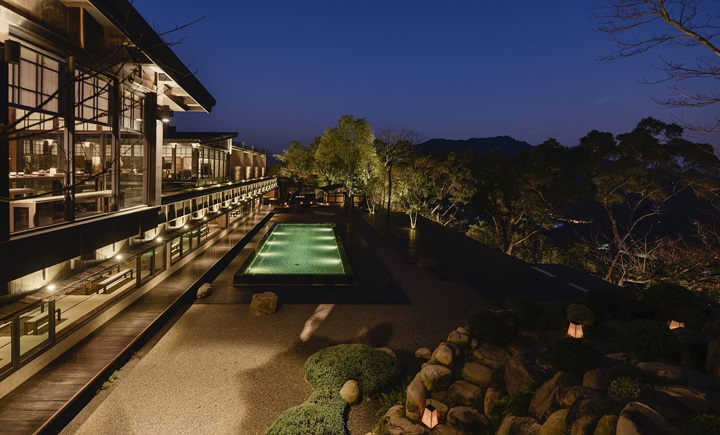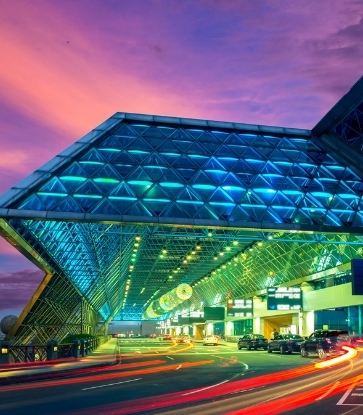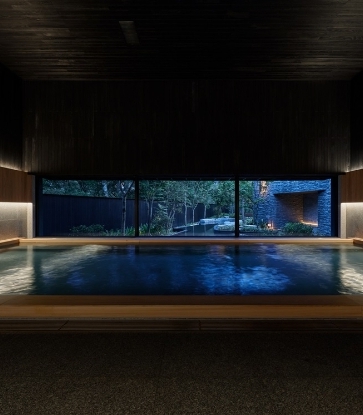Situated in sub-tropical climes, Taiwan’s beautiful landscapes range from ocean vistas and lakes to verdant forests and soaring mountains. The natural environment, warm, lush and ever-changing, lends itself to a bounty of harvests. Journey Taiwan through its dining table, a gateway to richer cultural experiences, beginning with its produce and ingredients.
RELATED: A MICHELIN Inspector's Love Letter to Taiwan: 5 Delightful Discoveries I've Encountered

Yangmingshan National Park: Free-range chicken and zen garden restaurants
Yangmingshan, located just an hour away in the outskirts of Taipei, encompasses the entire Datun Volcanic Range. Its lush greenery and proximity to the city has given it the moniker of being Taipei’s backyard. In the Japanese colonial era, Yangmingshan was spotlighted as one of the top twelve scenic places of Taiwan in local newspapers and compared to Japan’s famed Hakone region.
The park is a popular day trip destination for urban dwellers eager for respite from the hustle of city life, while the rich natural environment is a draw for eco-enthusiasts as well as bird- and butterfly-watchers. But what is also not to be missed is the delicious homecooking fresh from the farms up in the mountains.

Located within a small village in the park, Bib Gourmand-recommended Sung Chu Yuan is renowned for its dishes featuring free-range chicken and wild vegetables sourced from the surrounding mountains. The menu highlights classic chicken preparations in various styles, including poached and chopped, crispy-skinned, smoked, and in the traditional San Bei Ji (Three Cup Chicken) stew. To accompany are fresh stir-fried vegetables like betel flowers, Madeira vine and Okinawan spinach while the a bowl of chicken soup with mustard greens warms the soul and encapsulates the charm of Taiwanese farmhouse cooking.
RELATED: The Many Lives of Three Cup Chicken, a Taiwanese Classic

Tucked away along the winding roads of Yangming National Park is MICHELIN Green-Starred restaurant Yangming Spring (Shilin). The zen-inspired garden restaurant is spread out over an area of 1,700 square meters, with rooms linked by a manicured garden, rock sculptures and bonsai. The menu honors a vegan and zen ethos, offering an exquisite full-flavoured take on Chinese cuisine with no meat or dairy. The chefs pay special attention to the sourcing and selection of their ingredients, preparing them with the restaurant’s own extracted seed oil. Each meal is served in a slow and intentional manner, the ritual of the experience leaving diners both physically and mentally refreshed.

Enjoy nature in Taichung: Master of Mushroom (Xinshe) and Inflorescence
Up in the highlands of Taichung Basin, Xinshe District boasts balmy weather and scenic mountain scenery. The Sea of Flowers is held annually in Xinshe, attracting tourists from near and far. The region is also known for its high-quality produce such as mushrooms, grapes, ponkan oranges, star fruit and premium pears. Each trip to Xinshe promises to be a fruitful one for taking in the scenery and leaving with a haul of fresh produce.
RELATED: Spring Delights: 5 MICHELIN-Recommended Restaurants Showcasing Taiwan’s Seasonable Vegetables

Located by a country road surrounded by tranquil orchards and mushroom greenhouses, Master of Mushroom (Xinshe) is a mushroom-themed hot pot restaurant in Xinshe. Owned by a family of mushroom farmers stretching back three generations, the emphasis here is on the health benefits of the various fungi varieties. The soup is boiled with old free-range hens and a variety of mushrooms to pack an umami punch. After a meal, pick up souvenirs like dried mushroom snacks, crisps and even pasta.

Inflorescence, also located in Xinshe, offers a different dining experience. Located in a mountainside bamboo grove 465 meters above sea level, the restaurant sits within a carefully manicured Zen Japanese garden. The Japanese kaiseki menu is an elegant fusion of Chinese and Japanese cuisines – reserve ahead to end the meal with a traditional tea tasting ceremony.
Farm-to-table: Chang Ying Seafood House’s milkfish specialties
Milkfish farming in Tainan has a history of more than 400 years, with historical records of Anping Fish Farm in Tainan dating back to 17th Century Dutch Formosa, making milkfish a quintessential part of Taiwanese cuisine. A whole milkfish has 222 tiny spines, so Tainan locals have developed delicate fish bone removal techniques so diners can more easily enjoy the local speciality from head to tail.

Chang Ying Seafood House, located in the north gate of Tainan, uses milkfish from its own farm to prepare authentic milkfish dishes. The restaurant was established under the ‘Tian Ma Ma’ programme rolled out by the Council of Agriculture to train and sponsor rural women to start their own businesses selling local specialties. On the menu are milkfish dishes of every sort with different parts cooked in different ways to show off their unique textures: filets and fish maw are pan-fried while milkfish sausage, while fish innards and sausages are cooked in three-cup sauce.
RELATED: Best Seafood Restaurants in Taiwan

With bellies full, take the time to visit the Jingzaijiao Tile-paved Salt Fields in the Yunjia South Coastal National Scenic Area, the first salt field in Beimen dating back 200 years. Founded in the 17th Century, the Nankunshun Daitian Temple is also worth exploring to fully soak in the unique historical and cultural charm of this coastal region.
For milkfish connoisseurs, don’t miss other specialty restaurants that have been included in the MICHELIN Guide Taiwan such as Bib Gourmand A Xing Shi Mu Yu with its crispy fried fish maw and milkfish intestines; Yung Tung Milkfish in Xuejia – one of Taiwan’s five major milkfish production areas – that offers a broth made with fresh fish bones and fish meat; and Tainan North District’s Kaiyuan Road No Name Milkfish that draws a steady stream of customers from dawn.

Follow the wild chef to get to know the corners of Taiwan: EMBERS
Some restaurants are dining destinations, situated in secluded, scenic spots and drawing curious explorers; for others, chefs take on the role of the explorer, sourcing and bringing back unique ingredients and produce and inviting diners to travel and experience merely through taste.
MICHELIN Green-starred restaurant EMBERS in Taipei is one of the latter sort. Known as the “wild chef”, EMBER’s Wes Kuo is fan of the great outdoors, often going deep into the mountains and forests to visit Taiwan’s aboriginal tribes to learn about cooking with wild foraged vegetables and traditional seasoning and fermentation techniques like transforming soybeans with rice koji to impart deep umami to dishes. Kuo’s menu is an in-depth exploration of Taiwan’s wild food culture.

Similarly, the menu at MICHELIN Green-Starred restaurant Hosu references the seasonal changes in Taiwan’s mountains, seas, rivers and plains. Here, chef Ian Lee tells the story of Taiwan’s yesteryear with deep emotions and nuanced understanding of the land and its various ethnic groups so that each meal feels like an epic journey with him. Launching after the restaurant’s relocation at the end of 2024, the new menu will feature dishes like fish maw cooked with wild chili pepper and sea water in the style of the Ami aboriginal tribe, locally caught octopus prepared with seaweed foraged from the intertidal zone and carious Taiwanese rice cultivars such millet, Zailai or Penglai rice, demonstrating the diversity and beauty of Taiwan’s natural and cultural landscapes.
RELATED: Sustainable Dishes from MICHELIN Green Star Restaurants in Asia
The article is written by Mokki Hsiao and translated by Rachel Tan. Read the original article here.
Hero image: ©Shutterstock



















